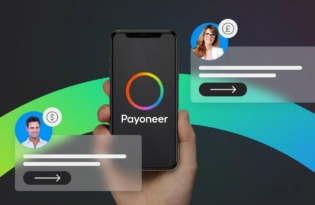HomeResourcesGeneral PaymentsAccount Payable
How to pay international vendors in order to promote profits and reduce risk
In this article, we’ll share our expert tips and best practices for paying international vendors, so you can focus on growing your business. From choosing the right payment method to navigating currency exchange, we’ve got you covered.

For businesses that operate internationally, establishing strong connections with foreign suppliers is crucial to ensuring seamless operations and continued while maintaining the brand’s reputation.
However, establishing trust can be difficult over long distances, particularly when language barriers are present. International suppliers and vendors can take several steps to enhance their relationships, such as maintaining open and honest communication through phone or video calls, with a translator if needed; implementing a standard ordering process; having a payment agreement; making timely payments; and regularly evaluating expectations to ensure the supplier can meet them. Most importantly, businesses must use a fast, dependable, and affordable method of payment.
The significance of quick and dependable payments
In international business partnerships, foreign suppliers are often most concerned about receiving payments. Just as a retailer’s operations can suffer from postponed shipments, a supplier’s operations can also be affected by delayed payments. Selecting a payment method that is fast, reliable, and secure is crucial to maintaining a healthy B2B relationship, preserving profitability, and upholding the brand’s reputation.
Forms of payments for global suppliers
Retailers might opt to make security deposits and installment payments to international suppliers before making a final payment. While security deposits may pose a risk to the seller, they can incentivize suppliers to adhere to agreements promptly in a good B2B relationship. It’s crucial to ensure that security deposit methods are quick and secure. Making installment payments throughout the manufacturing process at predetermined milestones can alleviate risk for overseas suppliers and help ensure the process runs smoothly. However, this approach may increase transaction costs, so it is essential to select a payment provider that offers competitive rates.
Bank wire?
One of the most common forms of payment abroad is the wire transfer. For the initial merchant-to-foreign-supplier payments, the risks are significant, and the protections or recourse available to the merchant are minimal if a transaction goes wrong. In addition, the transfer may suffer from delays (up to 5 working days or longer), high fees, and inflated margins. Those kinds of complications with paying international vendors can end even the most profitable B2B relationships before they have a chance to thrive.
PayPal? credit card?
For smaller transactions, which might need a little more assurance short-term, PayPal or credit cards may be acceptable forms of remittance by which to pay vendors. Assuming that a vendor decides to accept PayPal through account opening, this form of payment provides dispute resolution, security technology, and fraud and purchase protection. These features do make PayPal a safe solution for a company wondering how to pay international vendors.
However, PayPal charges comparatively higher fees than competitors and has hidden fees. Plus, for companies looking to pay internationally, PayPal does charge a higher foreign exchange rate than most other payment forms, so remember to add those on top of whatever fees may be applied by your payment method for foreign transactions, should you utilize those. Then there are dependability problems. PayPal can decide to restrict payment options if it feels that they pose too high of a risk.
If PayPal determines that the transaction poses too high of a risk, they will put a hold on the transaction, and delivery of products could be delayed, or even canceled. In a similar vein, credit cards also have higher fees for international transactions, they charge their own foreign transaction rates on the amount of the transactions, and users have to pay with a different account. This process not only becomes quickly expensive, adding up all those fees, but it can become tedious and complex for all parties. Oh, and don’t forget, credit cards always have hidden and surprise fees, so you may be surprised when you get your statement after you pay overseas supplier invoices with a credit card!
Peer-to-peer transfers?
Some small businesses have started engaging in foreign transfers through a peer-to-peer network. Peer-to-peer exchanges really support faster transfers, and they offer significant savings compared with banks. However, P2P currency exchange markets are not completely safe for customers. Transfer companies generally only offer a few currencies, often offering a bit more than spot rates. Companies that demand a target currency rate when they deposit funds might need to wait for one, and then their suppliers abroad might wait some time before they are paid. The small number of P2P exchange networks in existence and the high level of risk make these exchanges unsuitable for most small businesses.
Payoneer – The best way to pay overseas suppliers
To optimize revenue, global online sellers must exchange their foreign income for their local account at minimal transaction fees and also pay international suppliers at comparably low rates.
Utilizing Payoneer, sellers can conduct business on Amazon or any worldwide e-commerce platform or website and obtain payments in ‘collection accounts’ in the relevant currency.
Sellers can employ their collection account balances to execute local payments with zero fees in that specific currency.
Sellers can compensate suppliers without charge in regions where they maintain collection accounts and offer suppliers a method to charge their accounts routinely. Payoneer enables merchants to bypass regulatory compliance issues.
When it comes to handling international payments for businesses and their global vendors, an ideal solution offers competitive exchange rates, minimal risk, smooth transactions, quick processing, and security. Payoneer’s specialists in cross-border payments ensure compliance with each country’s regulations where you do business while offering round-the-clock, multilingual customer support for both you and your suppliers.
Related resources
Latest articles
-
Made in India for the World: The State of Indian Cross-Border eCommerce
The Indian eCommerce market has grown significantly in the last few years. As a result, many cross-border businesses have undergone a fast-paced digital transformation and contributed to surpassing the government-set $400 billion target of trade within a single year.
-
Defying the odds: How Ukrainian businesses thrive during war
One year post-war, Ukraine’s businesses adapt and thrive amidst adversity. Entrepreneurs showcase resilience, reflecting national tenacity. Many diversify, venturing into e-commerce and digital realms. Despite hurdles, 44% of SMBs aim for growth, with 36% hiring. Their grit underscores Ukraine’s enduring spirit amid challenges.
-
An 8-point Checklist for Finding the Best Payment Provider
There’s huge potential to expand into ASEAN markets. But only for online sellers that accept local payment methods. Finding a trusted payment solution can be a worry and a challenge. Use this checklist to vet potential payment partners. With the right payment support, the sky’s the limit!
-
How to bill your international clients
Want to learn how to bill international clients when you’re based in the Philippines? In this article we spoke to three leading business owners who shared their tips to working successful international work. Learn how they collect payments and more below.
-
How to nail your direct-to-consumer payment strategy
Asia-Pacific offers massive potential for DTC ecommerce. But cross-border payments can be a headache. We share an actionable strategy for DTC payments that’ll remove DTC payment hazards and expand your business with ease. What are you waiting for?
-
How to pay international vendors in order to promote profits and reduce risk
In this article, we’ll share our expert tips and best practices for paying international vendors, so you can focus on growing your business. From choosing the right payment method to navigating currency exchange, we’ve got you covered.














